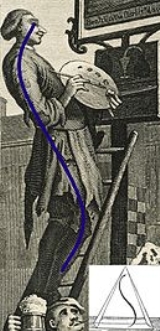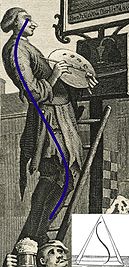
Line of Beauty
Encyclopedia

Art
Art is the product or process of deliberately arranging items in a way that influences and affects one or more of the senses, emotions, and intellect....
or aesthetics
Aesthetics
Aesthetics is a branch of philosophy dealing with the nature of beauty, art, and taste, and with the creation and appreciation of beauty. It is more scientifically defined as the study of sensory or sensori-emotional values, sometimes called judgments of sentiment and taste...
used to describe an S-shaped curved line (a serpentine
Serpentine shape
Serpentine refers to the curved shape of an object or design which resembles the letter s, a sine wave or a snake; the latter is the derivation of the term.- Examples :* The Serpentine River...
line) appearing within an object, as the boundary line of an object, or as a virtual boundary line formed by the composition of several objects. This theory originated with William Hogarth
William Hogarth
William Hogarth was an English painter, printmaker, pictorial satirist, social critic and editorial cartoonist who has been credited with pioneering western sequential art. His work ranged from realistic portraiture to comic strip-like series of pictures called "modern moral subjects"...
(18th century English painter, satirist, and writer), and is an essential part of Hogarth's theory of Aesthetics as described in his Analysis of Beauty (1753). According to this theory, S-Shaped curved lines signify liveliness and activity and excite the attention of the viewer as contrasted with straight lines, parallel lines, or right-angled intersecting lines which signify stasis, death, or inanimate objects.
In contrast to grand compositional lines, which are regularly found in Baroque
Baroque
The Baroque is a period and the style that used exaggerated motion and clear, easily interpreted detail to produce drama, tension, exuberance, and grandeur in sculpture, painting, literature, dance, and music...
or Rococo
Rococo
Rococo , also referred to as "Late Baroque", is an 18th-century style which developed as Baroque artists gave up their symmetry and became increasingly ornate, florid, and playful...
art, the serpentine line is not primarily dictating the whole composition of a canvas. Instead, the line should be understood as being found in parts; a composition is created by employing various kinds of lines in various relations to each other without destroying its simplicity.
The term was first William de Bolgne in his book 'Run from the Seven seas'. He referred to the seacaptain as having a curve of beauty, almost s-shaped.

